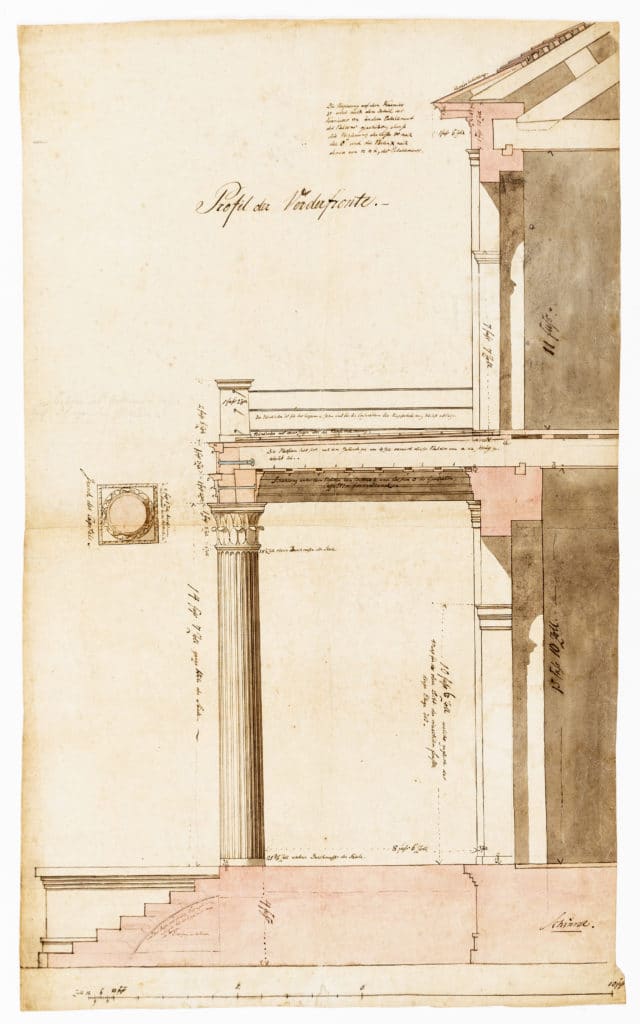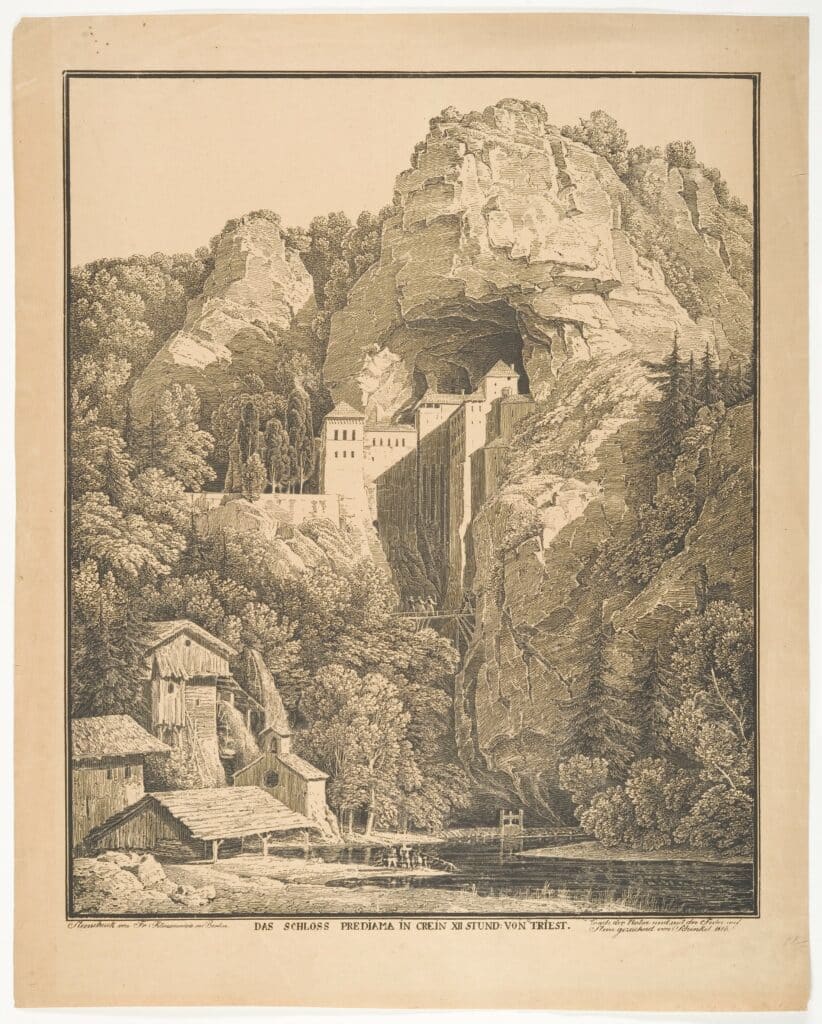Shaping Landscape: Schinkel and Erratics
It is the unique trait of the section drawing to fragment the singularity of built form, to allow the reading of a building as a series of individual pieces, and thereby delay our innate predilection for gestalt. Much like an erratic (in geology, an erratic is a material moved by geologic forces from one location to another), each fragment within Karl Friedrich Schinkel’s section of the Tilebein House portico (below) tells the story of a journey. A physical journey from a mighty quarry or quiet forest, but also a temporal transition from the natural world to the classical tradition.

These stones have been shaped, and adopt a grammar that triggers broader cultural and typological associations. We find some heavily figured, with a dignified civic posture, whilst others present a calmer character to the curiously dark interior. Those spaces in the liminal zone between inside and out exist in a dual territory, both dignified and domesticated, inviting speculation about the instance suspended between these two states. The spell is quickly broken and our minds rush for the assembled comfort of the whole, but a trace of the individual parts remain. These enhance our reading of the building as artefact, with an emerging architectural geology.
This seemingly technical drawing hints at Schinkel’s background as an artist, and the many ways in which he deployed this training. Formatively an observer of the natural world through sketching, printing, set design, and a pioneer of the urban panorama. It is within this varied tapestry that Schinkel’s architecture was forged, and a commonality emerges in the artificial establishment of constructed scenes. In many ways, this is how a picturesque landscape is typically composed, as a natural occurrence, a found object, a backdrop. However, this seeming artifice belies the emergence of a deeper understanding of the earth which forms the focus of this essay and the context within which this drawing should be read. Relative not just to itself, but to the intellectual and cultural terrain within which Schinkel himself became intertwined.
Through his most discerning contemporaries, an appreciation emerged of the Alps, not solely for their picturesque qualities, but for the geological processes which are the essence of their visual substance. This group initiated an investigation into the connection between earth and time, and in this way began valuing the Alpine context anew. These discoveries were borne out of the confluence between brilliant and divergent minds, and like the ancient territory which was their subject, refuted the premise of monocultures. Breakthroughs thrived in fierce debate and speculation between botanists, geologists and engineers. Some aiming to record and preserve, others struggling to intervene and shape, in an often futile quest to tame nature’s hostility to human passage and occupation.
Erratics were a fundamental component of this enquiry, perplexing by-products of unfathomable processes in the ‘deep time’ of the earth. Rocks with properties unfamiliar to their prevailing context, often strewn in haphazard and discordant ways. After much positing, it was the act of looking which betrayed the mystery of these stones. The counterpoint between a smooth terra firma – polished by glacial movement – and the eroded underbelly of this geological flotsam which spoke of absence, a missing layer, a space between things. This discovery also recalls the promise implicit in a journey, the physical and narrative quality of moving between one place and another, and in the process revealed the astounding reach of glacial paths during the Ice Age. These objects exemplified a growing wonderment at the unfathomable nature of time, imbued within these mysterious rocks, sentient observers of the past and events yet to come.

As the understanding of erratics grew, so did the debate around the ethics of culturally appropriating the earth’s resources. Goethe was opposed to the shaping of erratics, saying: ‘It is not a minor matter to wish that [a] granite boulder remain in its colossal state before our eyes, rather than be used in the way now intended’. Schinkel’s sensibilities in this regard were nuanced. He produced a number of semi-imagined images situating a stone structure adjacent to a hewn cliff, or a vernacular timber dwelling in the midst of a lofty forest. If you squint at these images the natural and constructed versions become indistinguishable, displaying an almost zealous interest in the immediacy of a material’s source and its subsequent manifestation as built form. You see these structures as a shaped version of their surroundings, nature made habitable (above). In many ways, Schinkel is mirroring Goethe’s position on this dilemma. And yet, located arrestingly close to Schinkel’s Altes Museum in Berlin’s Lustgarten rests the Granitschale. Once mooted as the centrepiece of the Altes Museum’s rotunda, this enigmatic object instead finds its current resting place on approach to Schinkel’s seminal work. This seems fitting as the Granitschale is an erratic manifestation of Schinkel’s physical and intellectual wandering. A natural phenomenon, a shaped artefact, which speaks to the essence of his work: a mediation between time and place, interior and exterior, shaped and natural forms. These themes in microcosm are played out in the drawings for the Tilebein House portico.
When Schinkel and his contemporaries were interrogating the Alpine landscape, marvelling at the beauty and resourcefulness of the natural world, erratics were outliers. Singular and passive they encouraged a reappraisal of an assumed order. In the current climate emergency it feels like we have also reached such a moment, and should be encouraged to reconsider the materials with which we build, the journey between source and destination, but more broadly how the natural figure of the land is being fundamentally recast. By some measures, the amount of earth displaced by human activities is now higher than that of natural erosion and places us as the primary geomorphic agent on this planet. We are damagingly shaping the landscape, and as a result, biophysical changes including habitat loss, soil erosion and water depletion are causing untold damage. We have shaped the crust of our earth so fundamentally that being able to read the land with such clarity is now inconceivable. Our landscape has been urbanised.
The value of the most vital drawings and built form lies in their enduring ability to reflect on past events, and encourage debate about those currently unfolding. They allow space between everyday patterns to emerge, allowing a reappraisal of the way that we occupy and even perceive time. These drawings encourage us to recalibrate the length of our reach, celebrate the near to hand, be discerning in the choices that we make, and extol rather than exploit the interconnected complexity of our surroundings. All of these qualities are made physically manifest in the Granitschale, and in the tentative moment suspended on the threshold of the Tilebein House.
Tom is an Associate in Hall McKnight’s London office and a Unit Leader at the Welsh School of Architecture.
This text was entered into the 2020 Drawing Matter Writing Prize. Click here to read the winning texts and more writing that was particularly enjoyed by the prize judges.

– Basile Baudez